Corrections and confirmations of the names of the assayers of the Durango mint 1811 – 1895
by José Antonio Juárez Muñoz
Director of the Museo de Numismática de Durango SEED
In the investigations that I have been able to carry out within the Historical Archive of the Government of the State of Durango (AHGED) we have located files (some already classified and others in the process of being so), as well as some Periódicos Oficiales, that give us the name of the Durango assayers. Up to now the mention of the assayers’ initials in various books and catalogs, based on the research of Dr. Alberto Pradeau Avilés and published in his work Numismatic History of Mexico has in the main been wrong. Dr. Pradeau relates some events that gave rise to the different administrations of the mint of Durango, as well as others related to the assayers, although he confesses to not knowing the name corresponding to several of the initials that appear on the coins. Likewise, others he deduces from some characters in the political history of the state as if they were the assayers, but without checking the sources of the files or newspapers from which he took that observation.
Therefore, I will here list the names and correct data of the characters, in chronological order, with the intention that the pertinent corrections will be made in the specialized books and catalogs.
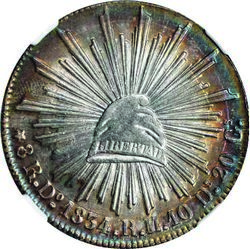
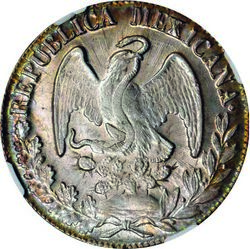
1.-Initials R.M. In 2022, a file was located in the Historical Archive of the State of Durango, in the Finance section, so today we know that they belong to Ramón Mascareñas, an assayer at the time of the War of Independence coins, and not to Ramón Mendoza, as mentioned in the book by Dr. Alberto Pradeau. The data was found in a still unclassified box of files in the section of “Hacienda” from 1811 in the time of the Nueva Vizcaya.
2.- Initials M.Z. Like the first ones these were located in still unclassified files in the Colonial section where the name appears as Mariano Zaldívar with his appointment as the main assayer of the Durango mint.
3.- Initials C.G. This assayer’s name, Cosme Garcés, was very hidden within the Archive’s documents. In the vast majority of documents from 1818 to 1823 his name was not mentioned and on one occasion did we locate a document of the year 1810 giving some reports of assays in the San Luis Potosí office, where his name is mentioned. It was not known if this was the same character but now we can be certain that when he finished his function as an assayer in San Luis Potosí he was hired in Durango for the years from1818. The reference is made in unclassified files for February 1823.
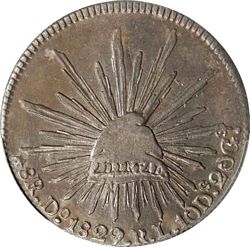
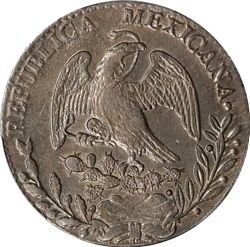
4.- Initials R.L. Nowadays we can be certain that these belong to Ramón Luelmo, as located in 2011, in the files of the Acts of Congress (Actas de Acuerdos y Decretos del Congreso del Estado de Durango) of 13 July 1826, which reported the payment to the assayer. This was outlined in my first book, Reseñas Históricas de Casa de Moneda de Durango 1811-1877, which was published in 2014.
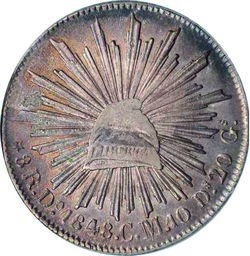
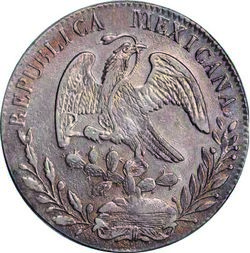
5.- Initials C.M. These belong to Cayetano Mascareñas and not to Clemente Morón, as was thought. This information was located in 2022, in file number 327 in the section “Correspondencias de la Secretaría General de Gobierno”.
Cayetano Mascareñas was the chief assayer in the years of 1848 and 1849. It is understood that it was only in the first months of this year that 8 reales coins were die-cut with his initials “C.M” since the lease contract of the Director Bernard Georgy was terminated and consequently the changes were made of of the assayer at the Durango mint.
However, it was this assayer who was ordered by the director to stamp the initials “B” and “G” on his 8 reales of 1848 and 1849, distributed on the obverses and reverses and representing the initials of Bernard Georgy. These initials have almost been found on most 1848 and few 1849 coins (since, as we have mentioned, Mascareñas was only at the mint for a few months of the latter year, before he retired).
A government inspection was trying to investigate the fraud of the counterfeiting of coins with a low silver content. It is said that director Bernard Georgy forbade entry to the government inspector and gave orders to the guards of the establishment that, if necessary, they should take out their weapons and use them to shoot this state government comptroller, named Dionisio Guerrero Tavizon, if he tried to pass. These are the violent stories of how these foreigners did whatever they wanted to do to have the support of characters within the government who were Conservatives.
After 17 years, Cayetano Mascareñas, returned in 1866 when the assayer Luis de la Torre (“L.T.”) left the mint and in 1867 when the French invaders were no longer in the state. There is a record that there were 431,000 pieces produced in that last year so that Carlos León de la Peña Muñoz (“C.P.”) who was a very accomplished and honest Liberal immediately returned. However, Mascareñas returned for the third time in the years 1873, 74, 75, 76 and 77.
A very interesting fact is that he worked for two years (1874 and 1875) he worked with another assayer named Jose Othón Huitrado (“J.H.”). These pieces are these are considered VERY RARE and RARE pieces
6.- Initials J.M.R. José María Ramírez only appears in a few months in the monthly assay reports in the Periódicos Oficiales, but Cayetano Mascareñas continued to exercise the role of jefe de ensayes until 1852, so, due to the lack of documentation, we are still unsure about this period in the life of the Durango mint.
7.- Initials C.P. These are of Carlos León de la Peña Muñoz, a declared liberal and patriotic supporter of President Benito Juárez against Maximilian, who was forced to leave the position of director of the Durango mint. He held several public offices, as well as that of professor at the Juárez Institute in 1875.
8.- Initials L.T. These belong to Luis de la Torre, as several documents refer to his appointment as director of the Durango mint in the years from 1859 to 1866. However, some receipts for payments for assays bear the name of a totally different person called Francisco Izurieta, though we do not know why.

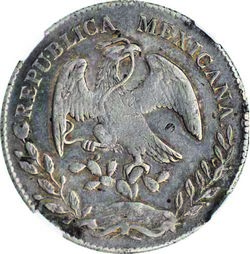
9.- Initials J.H. These belong to José O. Huitrado Aguilar, who was sent from Mexico City to perform the job of assayer. This information was found in the Periódico Oficial of December 1874 (data shared by my companion and numismatic colleague Javier Ruiz Celis).
10.- Initials J.M.P. These were said to belong to someone named José Miguel Palma but this name never appears in the records. However, Ingeniero José María Peimber was an assayer and then director of the mint at this time. Hence his three initials on the 1877 8 reales, the rarest pieces of the Durango mint.
11.- Initials P.E. These belong to Pedro Espejo and appeared in the Periódico Oficial of 19 September 1877 where it was announced that the assayer Carlos León de la Peña had been appointed Director General de Rentas in the state and that the new assayer would soon arrive to take up his position.
12.- Initials T.B. These belong to the assayer named Trinidad Barrera and appear in a file dated 14 November 1878 where there is talk of a trial of the previous assayer for mismanagement of the production of silver coins. This would have been Pedro Espejo who was replaced by Trinidad Barrera.
13.- Initials J.B. These belong to Jacobo Blanco. This name was confirmed in an original report of April 1885, provided to us from a private collection of an acquaintance in the United States, which includes the original signature of the assayer and a red seal of the Intervention of the mint of the government of Durango. Blanco replaced Manuel del Cerro, according to a letter dated 23 February 1885, in which the latter asked for permission to be absent from the office of assayer, to act as Interventor in the month of July. He returned as assayer according to a letter of 9 July of the same year. So the 8 reales with the initials J. B. are extremely scarce, as he performed his functions for just four months.

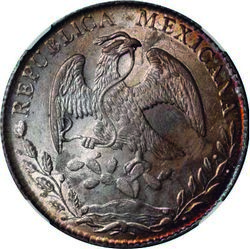
14.- Initials M.C. There is no doubt that these belong to Manuel del Cerro, although Pradeau asserted that these initials could correspond to one of two people: Manuel Canseco or Melchor Calderón. The correct name was found in documents in the section “Correspondencias de la Secretaría General de Gobierno” 1885. In these, addressed to the secretary general of the government, Manuel del Cerro asks for permission to retire for four months from his duties as assayer and Interventor (very special, since he had a double function within the mint).
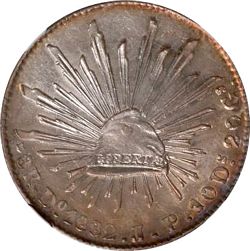

15.- Initials J.P. These are of Ingeniero José Gómez Palacios but were confused with those of another assayer, José María Peimbert (J.M.P.) because of the very similar initials. The original names were found in the Periódico Oficial of September 1890, where it is alluded that this person works as assayer and Interventor of the Durango mint. At the beginning of 1892 he went to Monterrey to establish the federal assay office and in 1895 he was summoned by Leandro Fernández to Mexico City to help him draw up the “Regulation of Mints” which at that time were being organised on a federal basis. In 1896 Gómez Palacios went to Culiacán as director of the city’s mint but only lasted two years until, sick through the climate, he returned to Monterrey. In addition, he held a position on the city council of Durango in the years from 1911 to 1912.
16.- Initials N.D. These are of Ingeniero Norberto Domínguez that appear in the files of “Correspondencias del Gobernador” of 1896. It is mentioned that he was highly recommended as being well prepared in the matter of the assay of metals and for having occupied the position as Interventor and assayer from 1892 to 1895. In addition to being a professor of meteorology at the Juárez Institute since 1892, he also held positions within the city council from 1892 to 1893 and from 1895 to 1897.
As an appendix I include a table giving the amount of silver coinage for each of the assayers of the Durango mint from 1824 to 1895. These figures are approximations based on data collected from archive files (from the Durango Mint section, 1824 to 1888, in the Center for Historical Studies of Mexico, Carlos Slim Foundation) and taking into consideration information from the Krause catalog section on Durango 8 reales (1889 to 1895).
These figures are the total of the silver pieces for ½, 1, 2 and 8 reales in addition to the pieces denominated in the decimal system such as those of 5. 10, 25 and 50 centavos and the balance scales pesos.
The table also includes information on the dates that each assayer held office. However, It should be noted that in some cases two or three assayers worked in the same year, sometimes for periods of a few weeks or months so it is very difficult to know exactly how many pieces are to be assigned to each of them due to the short time in which they were made and for the lack of documentary information.
| Dates | Assayer's name | initials | |
| 1824 to 1829 | Ramón Luelmo | R.L. | 3,590,813 |
| 1830 to 1849 | Ramón Mascareñas | R.M. | 15,483,663 |
| 1848 to 1849 and 1873 to 1877 | Cayetano Mascareñas | C.M. | 5,119,603 |
| 1849 to 1852 | José María Ramírez | J.M.R. | 1,941,994 |
| 1852 to 1864 and 1867 to 1873 | Carlos León de la Peña | C.P. | 11,659,379 |
| 1864 and1865 | Luis de la Torre | L.T. | 1,414,992 |
| 1872 and 1877 | José María Peimbert | J.M.P. | 1,166,976 |
| 1878 | Pedro Espejo | P.E. | 900,919 |
| 1878 to 1880 | Trinidad Barrera | T.B. | 2,668,035 |
| 1880 to 1882 | José Gómez Palacio | J.P. | 4,272,788 |
| 1882 to 1890 | Manuel del Cerro | M.C. | 9,206,211 |
| 1885 | Jacobo Blanco | J.B. | 1,131,644 |
| 1892 to 1895 | Norberto Domínguez | N.D. | 5,512,000 |
